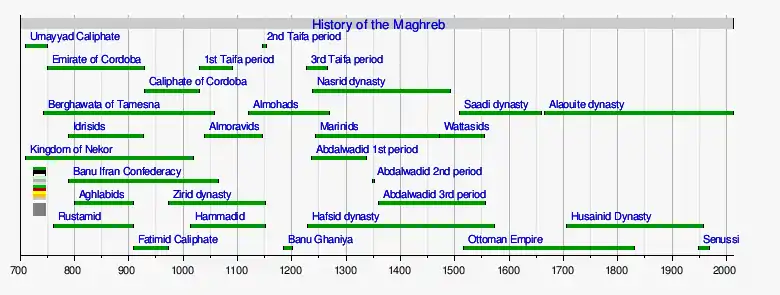Kingdom of Tlemcen
The Kingdom of Tlemcen or Zayyanid Kingdom of Tlemcen (Arabic: الزيانيون) was a Berber[3][4] kingdom in what is now the northwest of Algeria. Its territory stretched from Tlemcen to the Chelif bend and Algiers, and reached at its zenith the Moulouya River to the west, Sijilmasa to the south and the Soummam to the east.[5][6]
Zayyanid Kingdom of Tlemcen مملكة تلمسان (ar) | |||||||||||||||
|---|---|---|---|---|---|---|---|---|---|---|---|---|---|---|---|
| 1235–1554 | |||||||||||||||
 Flag of the Zayyanid Kingdom (1235–1338, 1488–1556)
 Flag of the Zayyanid Kingdom (1338–1488)
| |||||||||||||||
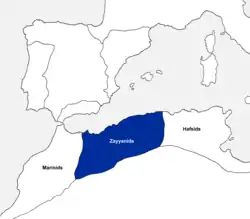 The kingdom of Tlemcen at the beginning of the 14th century.[2] | |||||||||||||||
| Capital | Tlemcen | ||||||||||||||
| Common languages | Berber, Maghrebi Arabic | ||||||||||||||
| Religion | Islam | ||||||||||||||
| Government | Monarchy | ||||||||||||||
| Sultan | |||||||||||||||
• 1236–1283 | Abu Yahya I bin Zayyan | ||||||||||||||
• 1550–1556 | Al Hassan ben Abu Muh | ||||||||||||||
| History | |||||||||||||||
• Independence from the Almohad Caliphate | 1235 | ||||||||||||||
• Annexation by the Ottoman Empire | 1554 | ||||||||||||||
| Currency | Dinar | ||||||||||||||
| |||||||||||||||
| Today part of | |||||||||||||||
Part of a series on the |
|---|
| History of Algeria |
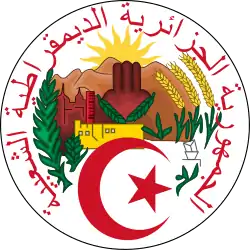 |
The Tlemcen Kingdom was established after the demise of the Almohad Caliphate in 1236, and later fell under Ottoman rule in 1554. It was ruled by sultans of the Zayyanid dynasty. The capital of the Tlemcen kingdom was centered at Tlemcen, which lay on the main east-west route between Morocco and Ifriqiya. The Kingdom Of Fez was centered at Fez, to the west of Tlemcen.
Tlemcen was also a hub on the north-south trade route from Oran on the Mediterranean coast to the Western Sudan. As a prosperous trading center, it attracted its more powerful neighbors. At different times the Moroccans from the west,[7] denizens of Ifriqiya from the east, and Aragonese from the north, invaded and occupied the kingdom.
Foundation
The Bānu ʿabd āl-Wād, also called the Bānu Ziyān or Zayyanids after Yaghmurasen Ibn Zyan, the founder of the dynasty, were leaders of a Berber group who had long been settled in the Central Maghreb. Although contemporary chroniclers asserted that they had a noble origin, little is known for sure.[8] The town of Tlemcen, called Pomaria by the Romans, is about 2,500 feet (760 m) above sea level in fertile, well-watered country.[9]
Tlemcen was an important center under the Almoravid dynasty and its successors the Almohad Caliphate, who began a new wall around the town in 1161.[10]
Yaghmurasen ibn Zayyan (1235–83) of the Bānu ʿabd āl-Wād was governor of Tlemcen under the Almohads.[11] He inherited leadership of the family from his brother in 1235.[12] When the Almohad empire began to fall apart, in 1235, Yaghmurasen declared his independence.[11] The city of Tlemcen became the capital of one of three successor states, ruled for centuries by successive Ziyyanid sultans.[13] Its flag was a white crescent pointing upwards on a blue field.[14] The kingdom covered the less fertile regions of the Tell Atlas. Its people included a minority of settled farmers and villagers, and a majority of nomadic herders.[11]
Yaghmurasen was able to maintain control over the rival Berber groups, and when faced with the outside threat of the Marinid dynasty, he formed an alliance with the Emir of Granada and the King of Castile, Alfonso X.[15] According to Ibn Khaldun, "he was the bravest, most dreaded and honorable man of the 'Abd-la-Wadid family. No one looked after the interest of his people, maintained the influence of the kingdom and managed the state administration better than he did."[12] Before his death he instructed his son and heir Uthman to remain on the defensive with the Marinid kingdom, but to expand into Hafsid territory if possible.[12] Under Yaghmurasen's leadership, and later under Abu Hammu II (1359–89), the kingdom pursued an expansionary policy, pushing towards Fez in the west and into the Chelif valley and Béjaïa in the east.[11]
List of Sultans of the Kingdom of Tlemcen
Economy
.jpg.webp)
The city of Tlemcen displaced Tahert (Tiaret) as the main trading hub in the central Maghreb, lying on the west-east route between Fez and Ifriqiya.
Another major route from Oran ran south through Tlemcen to the oases of the Sahara, and onward to the Western Sudan region to the south. The city was directly linked to Sijilmasa, which served as the main northern hub for the trade routes that crossed the desert to the Western Sudanese markets.[16] Oran, a port that the Andalusians had founded in the tenth century to handle the trade with Tahert, came to serve Tlemcen in its trade with Europe. Fez was nearer to Sijilmasa than Tlemcen, but the route to Fez led over the Atlas mountains, while the route to Tlemcen was easier for the caravans.[17] Yaghmurasan made an attempt to capture Sijilmasa in 1257, and succeeded in 1264, holding the town for almost ten years. The Marinids then took Sijilmasa, but most of the trade continued to flow through Tlemcen.[16]
The city of Tlemcen became an important center, with many schools, mosques and palaces.[8] Tlemcen also housed a European trading center (funduk) which connected African and European merchants.[18] In particular, Tlemcen was one of the points through which African gold (arriving from south of the Sahara via Sijilmasa or Taghaza) entered the European hands.[18] Consequently, Tlemcen was partially integrated into the European financial system. So, for example, Genoese bills of exchange circulated there, at least among merchants not subject to (or not deterred by) religious prohibitions.[19]
Tlemcen housed several well-known madrasas and numerous wealthy religious foundations, becoming the principal intellectual center of the central Maghreb. At the souq around the Great Mosque, merchants sold woolen fabrics and rugs from the East, slaves and gold from across the Sahara, local earthenware and leather goods, and a variety of Mediterranean maritime goods "redirected" to Tlemcen by corsairs—in addition to the intentional European imports available at the funduk.[20] Merchant houses based in Tlemcen, such as the al-Maqqari maintained regular branch offices in Mali and the Sudan.[21][22]
The ruler of Tlemcen is reported to have been advised by a Jewish viceroy named Abraham, who, in the time of the Inquisition of Torquemada, opened the gates of Tlemcen to Jewish and Muslim refugees fleeing Spain. Abraham is said to have supported them with his own money and with the tolerance of the king of Tlemcen.
14th century - political turmoil
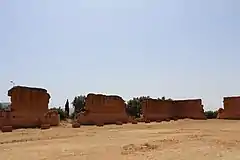
For most of its history the kingdom was on the defensive, threatened by stronger states to the east and the west. The nomadic Arabs to the south also took advantage of the frequent periods of weakness to raid the center and take control of pastures in the south.
The city of Tlemcen was several times attacked or besieged by the Marinids of Morocco, and large parts of the kingdom were occupied by the Moroccans for several decades in the fourteenth century.[11]
The Marinid Abu Yaqub Yusuf an-Nasr besieged Tlemcen from 1299 to 1307. During the siege he built a new town, al-Mansura, diverting most of the trade to this town.[16] The new city was fortified and had a mosque, baths and palaces. The siege was raised when Abu Yakub was murdered in his sleep by one of his eunuchs.[23]
Abu Yakub was succeeded by his sons Abu Thabit and Abu Rabi between 1307 and 1310, and then by his brother Abu Sa'id Uthman II, who came to the throne in 1310. Abu Sa'id was distracted by revolts of his son Abu Ali, the governor of Sijilmasa. Abu Sa'id died in 1331. His son Abu al-Hasan 'Ali (r. 1331–1351), the greatest Marinid Sultan, ended the internal quarrels and initiated an expansionary program.[24]
When the Marinids left in 1307, the Zayyanids promptly destroyed al-Mansura.[16] Tlemcen recovered its trade and its population grew, reaching about 40,000 by around the 1330s.[16] The Zayyanid king Abu Zayyan I died in 1308 and was succeeded by Abu Hammu I (r. 1308-1318). Abu Hammu was killed in a conspiracy instigated by his son and heir Ibn Tashufin (r. 1318-1337), who initiated hostilities against Ifriqiya while the Marinids were distracted by their internal struggles. Ibn Tashufin besieged Béjaïa, and sent an army into Tunisia that defeated the Hafsid king Abu Yahya Abu Bakr II, who fled to Constantine while the Zayyanids occupied Tunis.[23]
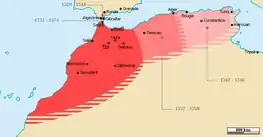
A Hafsid princess had married Sultan Abu'l Hasan of Fez, and the Hafsids appealed to him for help, providing a welcome excuse for invading his neighbor.[24] Abu'l Hasan initiated a siege of Tlemcen in 1335, and the city fell in 1337.[16] Ibn Tashufin died during the fighting.[23] Abu'l Hasan received delegates from Egypt, Granada, Tunis and Mali congratulating him on his victory, by which he had gained complete control of the trans-Saharan trade.[24] In 1346 the Hafsid Sultan, Abu Bakr, died and a dispute over the succession ensued. In 1347 Abu'l Hasan annexed Ifriqiya, briefly reuniting the Maghrib territories as they had been under the Almohads.[25]
However, Abu'l Hasan went too far in attempting to impose more authority over the Arab tribes, who revolted and in April 1348 defeated his army near Kairouan. His son, Abu Inan Faris, who had been serving as governor of Tlemcen, returned to Fez and declared that he was sultan. Tlemcen and the central Maghreb revolted.[25] The Zayyanid Abu Sa'id Uthman II (1348-1352) was proclaimed king of Tlemcen.[23] Abu'l Hasan had to return from Ifriqiya by sea. After failing to retake Tlemcen and being defeated by his son, Abu'l Hasan died in May 1351.[25] In 1352 Abu Inan Faris recaptured Tlemcen. He also reconquered the central Maghreb. He took Béjaïa in 1353 and Tunis in 1357, becoming master of Ifrikiya. In 1358 he was forced to return to Fez due to Arab opposition, where he feel sick and was killed.[25]
The Zayyanid king Abu Hammu Musa II (r. 1359-1389) next took the throne of Tlemcen. He had a long reign punctuated by fighting against the Marinids or various rebel groups.[23] The Marinids reoccupied Tlemcen in 1360 and in 1370.[26] In both cases, the Marinids found they were unable to hold the region against local resistance.[27] The historian Ibn Khaldun lived in Tlemcen for a period during the generally prosperous reign of Abu Hammu Musa II, and helped him in negotiations with the nomadic Arabs. He said of this period, "Here [in Tlemcen] science and arts developed with success; here were born scholars and outstanding men, whose glory penetrated into other countries." Abu Hammu was deposed by his son, Abu Tashfin II (1389–94), and the state went into decline.[28]
Disintegration and fall
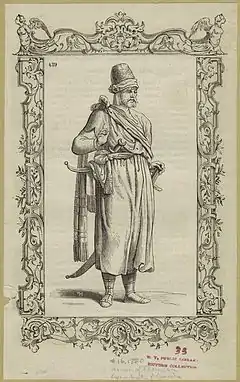
In the 15th century, expansion eastward was attempted, but proved disastrous. The state was increasingly weak and became intermittently a vassal of Hafsid Ifriqiya, Marinid Morocco or the Crown of Aragon.[29]
By the end of the fifteenth century the Kingdom of Aragon had gained effective political control, intervening in the dynastic disputes of the amirs of Tlemcen, whose authority had shrunk to the town and its immediate neighborhood.[28] When the Spanish took the city of Oran from the kingdom in 1509, continuous pressure from the Berbers prompted the Spanish to attempt a counterattack against the city of Tlemcen (1543), which was deemed by the Papacy to be a crusade. The Spanish failed to take the city in the first attack, but the strategic vulnerability of Tlemcen caused the kingdom's weight to shift toward the safer and more heavily fortified corsair base at Algiers.
Tlemcen was captured in 1554 by the Ottoman Empire under Salih Reis, the Pasha of Algiers.[10] The last sultan's son escaped to Oran, then a Spanish possession. He was baptized and lived a quiet life as Don Carlos at the court of Philip II of Spain.
Under the Ottoman Empire the town quickly lost its former importance, becoming a sleepy provincial town.[30] The failure of the kingdom to become a powerful state can be explained by the lack of geographical or cultural unity (despite the differences between the cultures of the Western Marinid, Central Zayyanid, and Eastern Hafsid Maghreb, all three cultures at the time were still developing, and only became fully fleshed out after the Ottoman conquest), the constant internal disputes and the reliance on irregular Arab-Berber nomads for the military.[15]
Chronology of events
- 1236-1248 : Independence war with the Almohad Caliphate
- 1272 : Oujda and Sijilmasa lost to Marinids[31]
- 1299–1307 : Tlemcen besieged by Marinids[32]
- 14th century : Oujda recaptured from Marinids
- 1313 : Algiers annexed to the Kingdom of Tlemcen[32]
- 1337–1348 : 1st period of Moroccan occupation[33]
- 1352–1359 : 2nd period of Moroccan occupation[33]
- 1366 : Expedition to Bejaia defeated
- 1389–1424 : Zayyanids recognize Marinid suzerainty[32]
- 1390 : Barbary Crusade
- 1424–1500 : Zayyanids recognize Hafsid suzerainty[32]
- 1427–1429 : Civil war
- 1503–1512 : War with Spain
- Mers el Kebir and Oran lost to Spain[32]
- Siege of Algiers in 1510
- Tlemcen besieged by Spanish forces
- 1512, war ends. Tlemcen becomes a puppet of the Kingdom of Aragon
- 1517 : Tlemcen besieged by Aruj's army[32]
- 1518 : Independence restored after Aruj's victory over the Spanish[32]
- 1543 : Spanish occupation
- 1543–1544 : 3rd period of Moroccan occupation
- 1550 : Tlemcen occupied by Ottoman Turks
- 1554 : the Kingdom of Tlemcen becomes an Ottoman protectorate
- 1556 : Western Algeria becomes a beylik of the Regency of Algiers
References
Citations
- Baydal Sala, Vicent (19 Nov 2017). "Religious motivations or feudal expansionism? The Crusade of James II of Aragon against Nasrid Almeria in 1309-10". Complutense University of Madrid.
- Baydal Sala, Vicent (19 Nov 2017). "Religious motivations or feudal expansionism? The Crusade of James II of Aragon against Nasrid Almeria in 1309-10". Complutense University of Madrid.
- "Abd al-Wadid Dynasty | Berber dynasty". Retrieved 2016-07-22.
- Appiah, Anthony; Gates, Henry Louis (2010-01-01). Encyclopedia of Africa. Oxford University Press. ISBN 9780195337709.
- The Abdelwadids (1236–1554), on qantara-med.org
- L'Algérie au passé lointain – De Carthage à la Régence d'Alger, p175
- Despois et al. 1986, p. 367.
- Bel. 1993, p. 65.
- John Murray 1874, p. 209.
- John Murray 1874, p. 210.
- Niane 1984, p. 93.
- Tarabulsi 2006, p. 83.
- Ruano 2006, p. 309.
- Hrbek 1997, pp. 34-43.
- 'Abd al-Wadid: Britannica.
- Niane 1984, p. 94.
- Fage & Oliver 1975, p. 356.
- Talbi 1997, p. 29.
- Braudel 1979, p. 66.
- Idris 1997, pp. 44-49.
- Niane 1997, p. 245-253.
- Kasaichi 2004, p. 121-137.
- Tarabulsi 2006, p. 84.
- Fage & Oliver 1975, p. 357.
- Fage & Oliver 1975, p. 358.
- The Abdelwadids (1236-1554): Qantara.
- Hrbek 1997, pp. 39.
- Niane 1984, p. 95.
- Hrbek 1997, pp. 41.
- Wingfield 1868, p. 261.
- Caverly 2008, p. 45.
- Political Chronologies of the World, pp. 1-18.
- Marçais 1986, p. 93.
Sources
- "'Abd al-Wadid". Encyclopædia Britannica. I: A-Ak - Bayes (15th ed.). Chicago, IL: Encyclopædia Britannica, Inc. 2010. pp. 16. ISBN 978-1-59339-837-8.
- Bel., A. (1993). "'Abdalwadides". First Encyclopaedia of Islam: 1913-1936. BRILL. p. 65. ISBN 978-90-04-09796-4. Retrieved 2013-05-15.
- Braudel, Fernand (1979). Civilization and Capitalism, 15th-18th Century: Vol. III: The Perspective of the World. Translated by Sian Reynolds. Univ. Calif. Press & HarperCollins.
- Caverly, R. William (2008). "Hosting Dynasties and Faiths: Chronicling the Religious History Of a Medieval Moroccan Oasis City" (PDF). Archived from the original (PDF) on 2014-07-14.
- Despois, J.; Marçais, G.; Colombe, M.; Emerit, M.; Despois, J.; Marçais, PH. (1986) [1960]. "Algeria". In Bearman, P.; Bianquis, Th.; Bosworth, C.E.; van Donzel, E.; Heinrichs, W.P. (eds.). Encyclopaedia of Islam. I (2nd ed.). Leiden, Netherlands: Brill Publishers. ISBN 9004081143.
- Fage, John Donnelly; Oliver, Roland Anthony (1975). The Cambridge History of Africa. Cambridge University Press. p. 356. ISBN 978-0-521-20981-6. Retrieved 2013-05-15.
- Hrbek, I. (1997). "The disintegration of political unity in the Maghrib". In Joseph Ki-Zerbo & Djibril T Niane (ed.). General History of Africa, vol. IV: Africa from the Twelfth to the Sixteenth Century. UNESCO, James Curry Ltd., and Univ. Calif. Press.
- Idris, R. (1997). "Society in the Maghrib after the disappearance of the Almohads". In Joseph Ki-Zerbo & Djibril T Niane (ed.). General History of Africa, vol. IV: Africa from the Twelfth to the Sixteenth Century. UNESCO, James Curry Ltd., and Univ. Calif. Press.
- John Murray (1874). A handbook for travellers in Algeria. Retrieved 2013-05-15.
- Kasaichi, Masatochi (2004). "Three renowned 'ulama' families of Tlemcen: The Maqqari, the Marzuqi and the 'Uqbani". J. Sophia Asian Studies (22).
- Marçais, G. (1986) [1960]. "ʿAbd al- Wādids". In Bearman, P.; Bianquis, Th.; Bosworth, C.E.; van Donzel, E.; Heinrichs, W.P. (eds.). Encyclopaedia of Islam. I (2nd ed.). Leiden, Netherlands: Brill Publishers. ISBN 9004081143.
- Niane, Djibril Tamsir (1984). Africa from the Twelfth to the Sixteenth Century: 4. University of California Press. p. 93. ISBN 978-0-435-94810-8. Retrieved 2013-05-15.
- Niane, Djibril Tamsir (1997). "Relationships and exchanges among the different regions". In Joseph Ki-Zerbo & Djibril T Niane (ed.). General History of Africa, vol. IV: Africa from the Twelfth to the Sixteenth Century. UNESCO, James Curry Ltd., and Univ. Calif. Press.
- Political Chronologies of the World, vol.4 : A Political Chronology of Africa. Taylor & Francis. 2001. ISBN 9781857431162.
- Ruano, Delfina S. (2006). "Hafsids". In Josef W Meri (ed.). Medieval Islamic Civilization: an Encyclopedia. Routledge.
- Talbi, M. (1997). "The Spread of Civilization in the Maghrib and its Impact on Western Civilization". In Joseph Ki-Zerbo & Djibril T Niane (ed.). General History of Africa, vol. IV: Africa from the Twelfth to the Sixteenth Century. UNESCO, James Curry Ltd., and Univ. Calif. Press.
- Tarabulsi, Hasna (2006). "The Zayyanids of Tlemcen and the Hatsids of Tunis". IBN JALDUN: STUDIES. Fundación El legado andalusì. ISBN 978-84-96556-34-8. Retrieved 2013-05-15.
- "The Abdelwadids (1236-1554)". Qantara 2008. Retrieved 2013-05-15.
- Wingfield, Lewis (1868). Under the Palms in Algeria and Tunis ... Hurst and Blackett. Retrieved 2013-05-15.
External links
| Wikimedia Commons has media related to Zayyanid dynasty (Kingdom of Tlemcen). |
